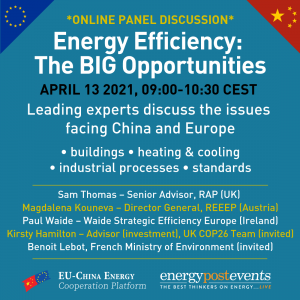CHINA: Carbon Neutral by 2060
the business opportunities for EU energy solutions providers
A series of three online workshops jointly organised by ECECP and EnergyPost.eu
WORKSHOP 3: Efficiency First – Session 1

Plus Guido Giacconi, CEO, In3Act and former Chair, Energy Working Group, EUCCC, Beijing (CHINA)
Session One: The Big Opportunities and Beyond
09:00 to 10:30 (CET) Tuesday 13 April 2021
A look at what has been achieved in the EU and how. With many of the low-hanging fruits having been exploited, where do we go now? Industrial processes, universal standards, renovation? And how does the situation in China compare with Europe? This opening session will offer insights across the Energy Efficiency agenda, setting the scene for the rest of the conference.

Benoit Lebot
Senior Policy Advisor, FRENCH MINISTRY FOR THE ECOLOGICAL TRANSITION

Sam Thomas
Senior Advisor, RAP (REGULATORY ASSISTANCE PROJECT)

Magdalena Kouneva
Director General, REEEP (RENEWABLE ENERGY AND ENERGY EFFICIENCY PARTNERSHIP)

Guido D. Giacconi
Founder and Chairman, In3Act and former Chair, Energy Working Group, EUCCC BEIJING

Paul Waide
CEO, WAIDE STRATEGIC EFFICIENCY EUROPE
Highlights
Policymakers have four legs to address climate change: lifestyle and behaviour change, renewable energy, carbon sequestration and energy efficiency.
Energy efficiency of the global energy system has doubled in the past 30 years, but there is still massive potential. Under most scenarios energy efficiency is the largest, most cost-effective way to decarbonise the world, and should be aiming to contribute to at least a 50% reduction in emissions. To deliver this there needs to be a huge effort to build human capacity and put in place a policy framework to mobilise finance.
International collaboration on energy efficiency is needed, the same way countries collaborate on developing hydrogen, nuclear power, or carbon capture and storage technologies. This will not only help all countries achieve faster and cheaper energy efficient solutions, but shared climate goals could help ease political tensions, for example between the US and China.
International standards of energy performance across all sectors and industries need to be made more visible so people have the information they need to make more energy efficient choices. Capital is available, but there are not enough investment-ready projects for them to fund, at least not of the size and depth required to have a major impact.
Wide-reaching regulations need to be put in place, and financial incentives alone won’t be enough. Many of the measures will be politically unpopular, so there needs to be major public engagement to understand the changes they need to make to address the crisis.
However, there will be major additional benefits to doing so; job creation, cost-savings, productivity increase and health benefits. In Asia more than 30% of adult deaths are attributable to fossil fuel air pollution. In Europe it’s 16%.
China and the EU focused on driving energy efficiency
- China and the EU both have ambitious mid-term and long-term climate targets, with a focus on energy efficiency.
- Both have a mixture of regulatory pricing and supporting policy measures to drive the market towards cost-effective energy efficiency solutions.
- Shared decarbonisation aims help overcome geopolitical tensions between China and the US.
- While learning should be shared, differences need to be understood. The model for Europe, with 27 countries, and for China are totally different, not only from a political standpoint, but from geographical, social, technological, and energy system standpoints.
- China’s energy efficiency challenges are different; 60% of its primary energy source is coal and coal makes up 85% of the electricity mix. Electrifying its vehicle fleet will actually increase emissions.
Buildings are the EU’s focus this decade
- The direct emissions from heating Europe’s homes now generates more emissions than all of Europe’s coal power plants.
- Energy efficiency in buildings will be a focus for Europe over the next decade. The European Commission foresees a 60% reduction in emissions from buildings between 2015 and 2030; this will require a complete overhaul in policy for both energy efficiency and heating decarbonisation in homes.
- The European Commission sees one in four homes switching from fossil fuel heating to electric heating. To do that it will need to rebalance carbon pricing, expand the regulation of utilities and increase taxes on fossil fuels.
- But it will need better demand-side energy management to deal with the intermittency of renewables. Better communication is needed between storage and the systems to displace energy use when it’s not needed, and also to store energy and send it back to the grid.
- Incumbents, particularly in gas, are putting forward politically persuasive arguments around continuing to use their gas networks to pump hydrogen for space heating, even though most economic analyses show that the direct burning of hydrogen in homes is not a cost-effective solution.
- Energy efficiency regulations will be expanded to apply to all homes, not just new-builds and major renovations.
- It is politically very difficult to regulate homeowners to improve energy efficiency, but there are sectors of the building stock, such as the private rented and commercial sector, where it is more feasible.
- Strong public engagement is needed on what’s required to be carbon neutral by 2050 – and what that implies for the assets that they own, especially their buildings.
- Need to create strong, up-front investment signals to convince owner-occupiers of a building to make major investments in energy efficiency.
- Many markets outside of Europe don’t have any standards in place to indicate the energy efficiency performance of buildings.
Visibility of energy performance across all sectors
- Energy markets don’t work effectively with regard to energy efficiency unless measures are put in place to overcome market barriers, such as access to finance, fragmented supply chains, barriers to knowledge, and split incentives.
- Regulatory frameworks can regulate inefficient uses and create the stick of removing inefficient practices, and the carrots of financial incentives.
- Energy efficiency needs to be visible to users and the marketplace so competing services can be compared and users can take action
- 37% of countries don’t have any equipment or product energy efficiency standards in place. Even in the countries which do, standards are not comprehensive.
- In Europe, not everyone knows the energy performance of their building, despite the EU’s buildings energy performance rating scheme in place for 15 years.
- Measurements need to be more thorough and holistic.
- Measurements need to be dynamic; users need to see how real-time performance and the real-time consequences of their actions impact energy performance.
- Measurements need to be more ambitious. Progress has been made optimising energy efficiency during the use of projects, but not across the full product life-cycle, from manufacturing, distribution, use, recycling and disposal.
Emerging markets
- There has been significant private capital invested in green energy and sustainable investment over the past two years, driven by falling technology costs and new business models.
- The challenge now is to shift the focus away from large emerging markets towards less-developed country economies, and to scale-down projects so that they can be applied at a sub-national level.
- The challenge is not the shortage of capital but a lack of projects which are investment ready.
- Need to find a way to transfer effective models and technologies to developing countries so they can leapfrog development to green and efficient energy use. These markets need to be a focus because it is where, due to growing populations and a rapid urbanisation agenda, most growth in energy demand will be seen.
- There is a lot of interest in green banking in developing and creating national climate finance facilities.
- Need to focus on building the green banking sector within local economies, to provide credit enhancement and guarantees for projects to attract private capital.
- Large scope for cooperation between the EU and the rest of the world, especially with developing nations, to adopt the EU’s taxonomy standards for energy efficiency and clean energy investments.